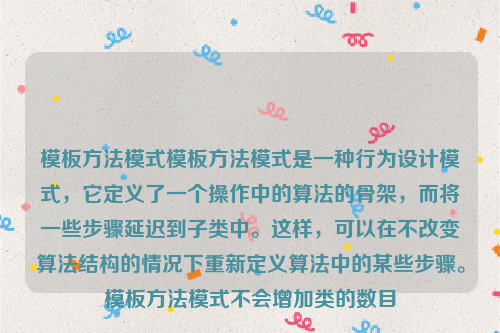模板方法模式是一种行为设计模式,它定义了一个操作中的算法的骨架,而将一些步骤延迟到子类中。这样,可以在不改变算法结构的情况下重新定义算法中的某些步骤。模板方法模式不会增加类的数目。
1、抽象父类:包含一个或多个抽象方法,这些方法是算法的骨架。
2、具体子类:继承抽象类,实现抽象方法的具体步骤。

3、客户端:通过调用具体的子类的实例方法来实现算法。
以下是一个简单的模板方法模式的实现示例:
// 抽象基类
public abstract class Shape {
protected void draw() {
System.out.println("Drawing a shape...");
}
protected abstract void fill();
protected abstract void remove();
}
// 具体子类
public class Circle extends Shape {
@Override
protected void fill() {
System.out.println("Filling the circle...");
}
@Override
protected void remove() {
System.out.println("Removing the circle...");
}
}
public class Rectangle extends Shape {
@Override
protected void fill() {
System.out.println("Filling the rectangle...");
}
@Override
protected void remove() {
System.out.println("Removing the rectangle...");
}
}
// 客户端代码
public class Main {
public static void main(String[] args) {
Shape shape = new Circle();
shape.draw(); // 输出:Drawing a shape...
shape.fill(); // 输出:Filling the shape...
shape.remove(); // 输出:Removing the shape...
shape = new Rectangle();
shape.draw(); // 输出:Drawing a shape...
shape.fill(); // 输出:Filling the shape...
shape.remove(); // 输出:Removing the shape...
}
}在这个示例中,Shape是一个抽象类,它定义了绘制、填充和移除形状的方法。Circle和Rectangle是具体的子类,它们实现了抽象类中的方法,并提供了具体的实现,客户端代码创建了Shape类型的对象,并通过调用其draw、fill和remove方法来执行相应的操作。




